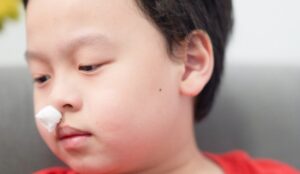When my baby was just a few days old, she developed jaundice. As a first-time mom, I was super anxious. I couldn’t sleep, and all I could think was: “Is something wrong?”, “Does she need to go to the hospital?”, “Will it cause long-term problems?” Looking back, I realized that newborn jaundice is actually very common and usually nothing to worry about. I’m writing this to help other parents feel more calm and prepared.
What Is Newborn Jaundice?
Newborn jaundice is when your baby’s skin and the whites of their eyes look yellow. It’s super common—over half of all newborns get it.
The yellow color comes from something called bilirubin, which is made when red blood cells break down. Normally, the liver helps get rid of bilirubin. But in newborns, the liver is still learning to work properly, so it may take a bit longer to clear it out. That’s why bilirubin builds up and causes the yellow tint.
Types of Jaundice
There are two main kinds:
- Normal (Physiological) Jaundice
This is the most common kind and usually shows up around day 2–3 after birth. It peaks around day 4–5 and goes away on its own in about a week. It doesn’t harm your baby. - More Serious (Pathological) Jaundice
If jaundice shows up in the first 24 hours, gets worse quickly, or lasts more than 2 weeks, doctors will want to check further. It could be caused by things like blood type differences or infections and may need treatment.
How Can Parents Spot It?
Press gently on your baby’s forehead or chest in good natural light. If the skin looks yellow where you press, your baby likely has jaundice.
But to know how serious it is, doctors need to check bilirubin levels with a blood test or a special light scanner.
Call your doctor or go to the hospital if:
When to Worry
- Jaundice appears in the first 24 hours
- The yellow color gets darker or spreads to arms and legs
- Baby is very sleepy, not feeding well, or has a weak cry
- Jaundice lasts more than 2 weeks (in full-term babies)
- Your baby is premature or has a family history of jaundice issues
Does Jaundice Need Treatment?
- Mild jaundice usually goes away on its own. Feeding often and sunlight (indirect, gentle sunlight—not harsh midday sun) can help.
- More serious cases may need phototherapy, where your baby lies under a special blue light. In rare cases, a blood exchange treatment is needed—but that’s only if levels get very high.
What Can Parents Do?
- Feed your baby often: Whether breastfeeding or formula-feeding, frequent feeding helps remove bilirubin through poop.
- Watch the color: Especially on the face, chest, arms, and legs.
- Don’t skip follow-up visits: Some hospitals schedule a bilirubin check after your baby goes home.
- Avoid home remedies: Don’t use herbal teas or unknown treatments for jaundice. Stick to medical advice.
Can Jaundice Cause Long-Term Problems?
Most of the time, no. But if bilirubin levels get very high and aren’t treated, it can affect the brain—a very rare condition called kernicterus. This is why early checks and treatment matter.
Final Thoughts
Jaundice might look scary, but it’s usually harmless and part of many babies’ normal first days. The most important thing is to monitor it and stay in touch with your doctor. If your doctor says it’s normal, trust the process—and keep loving on your little one.













